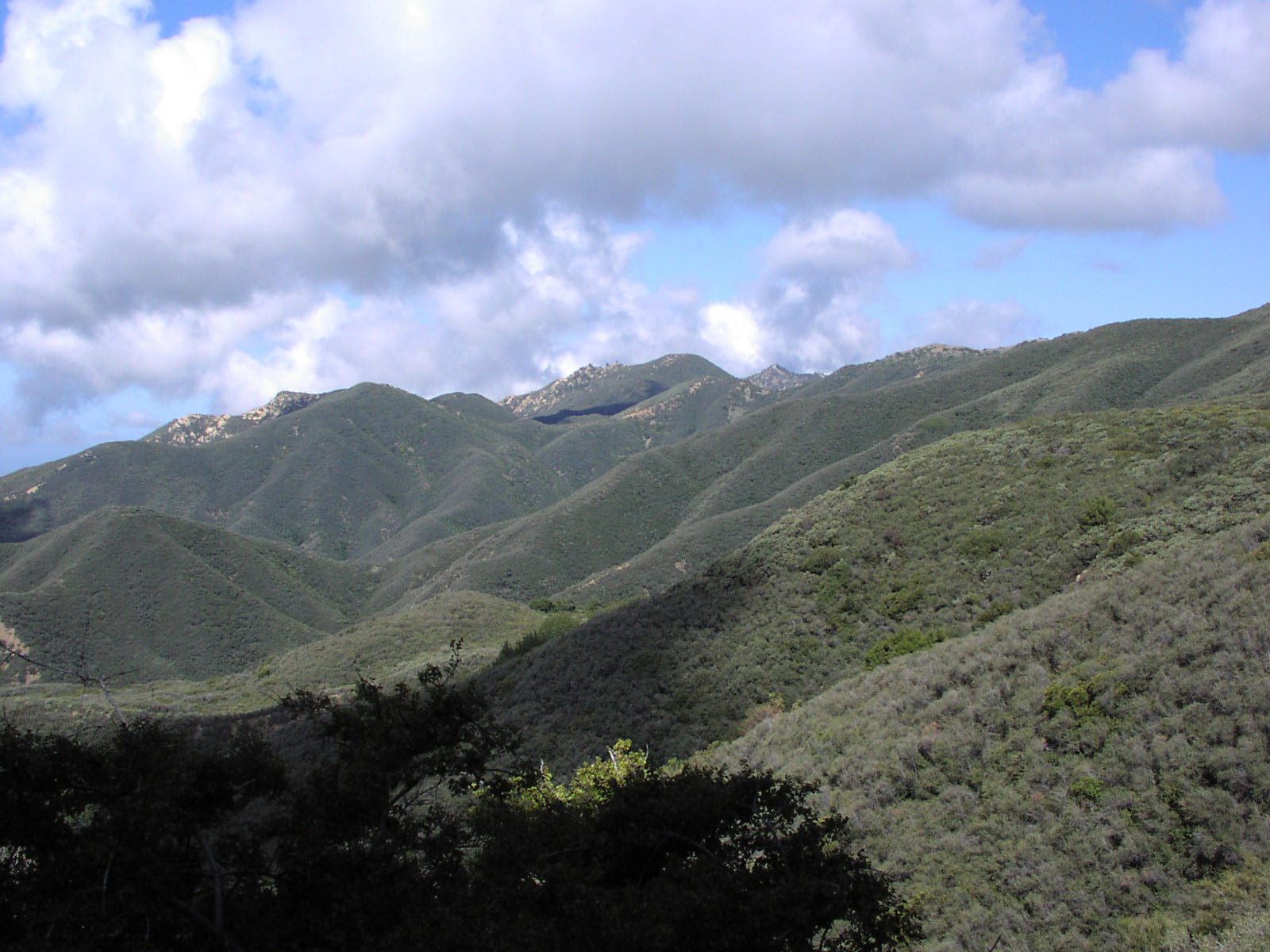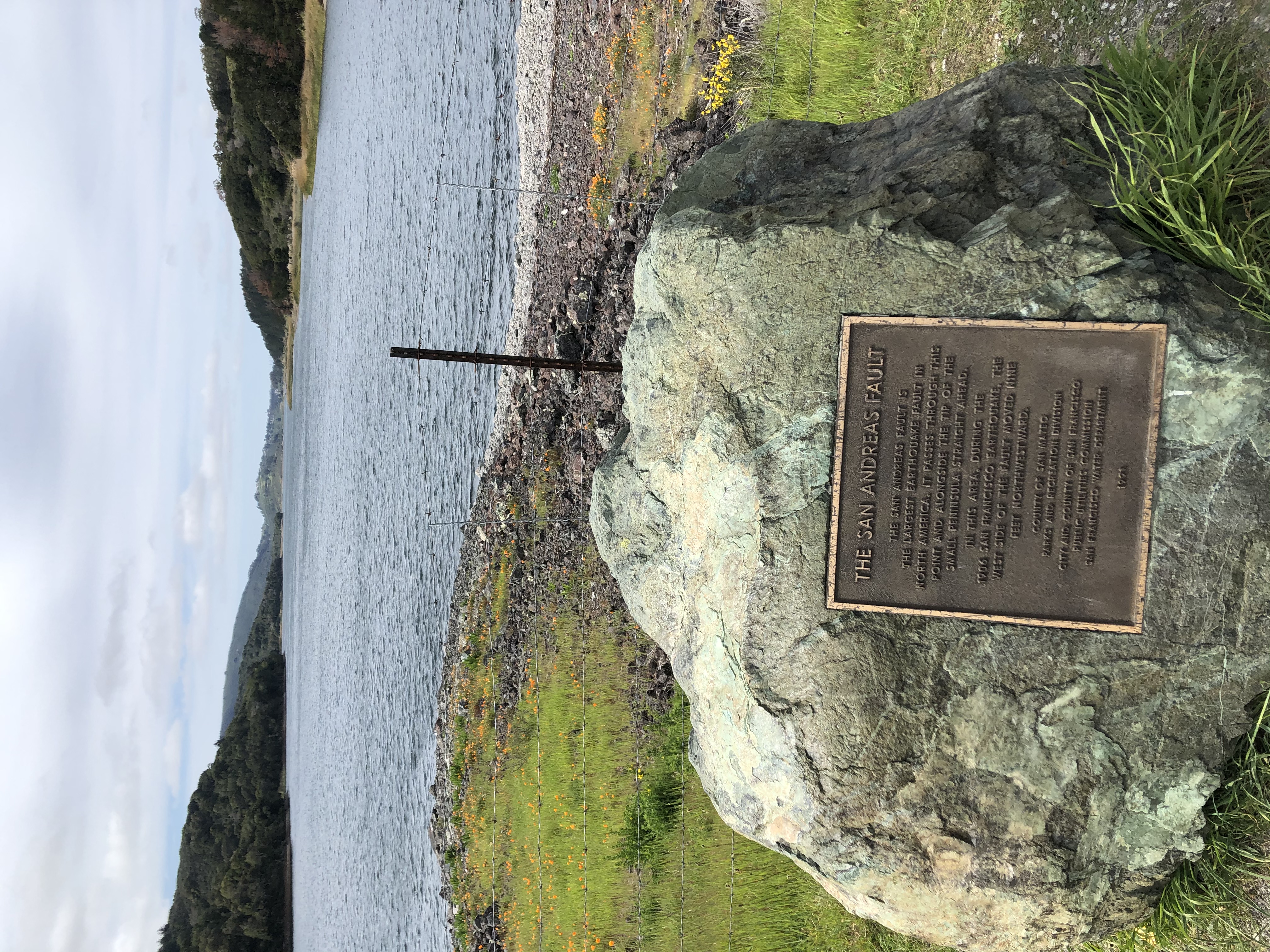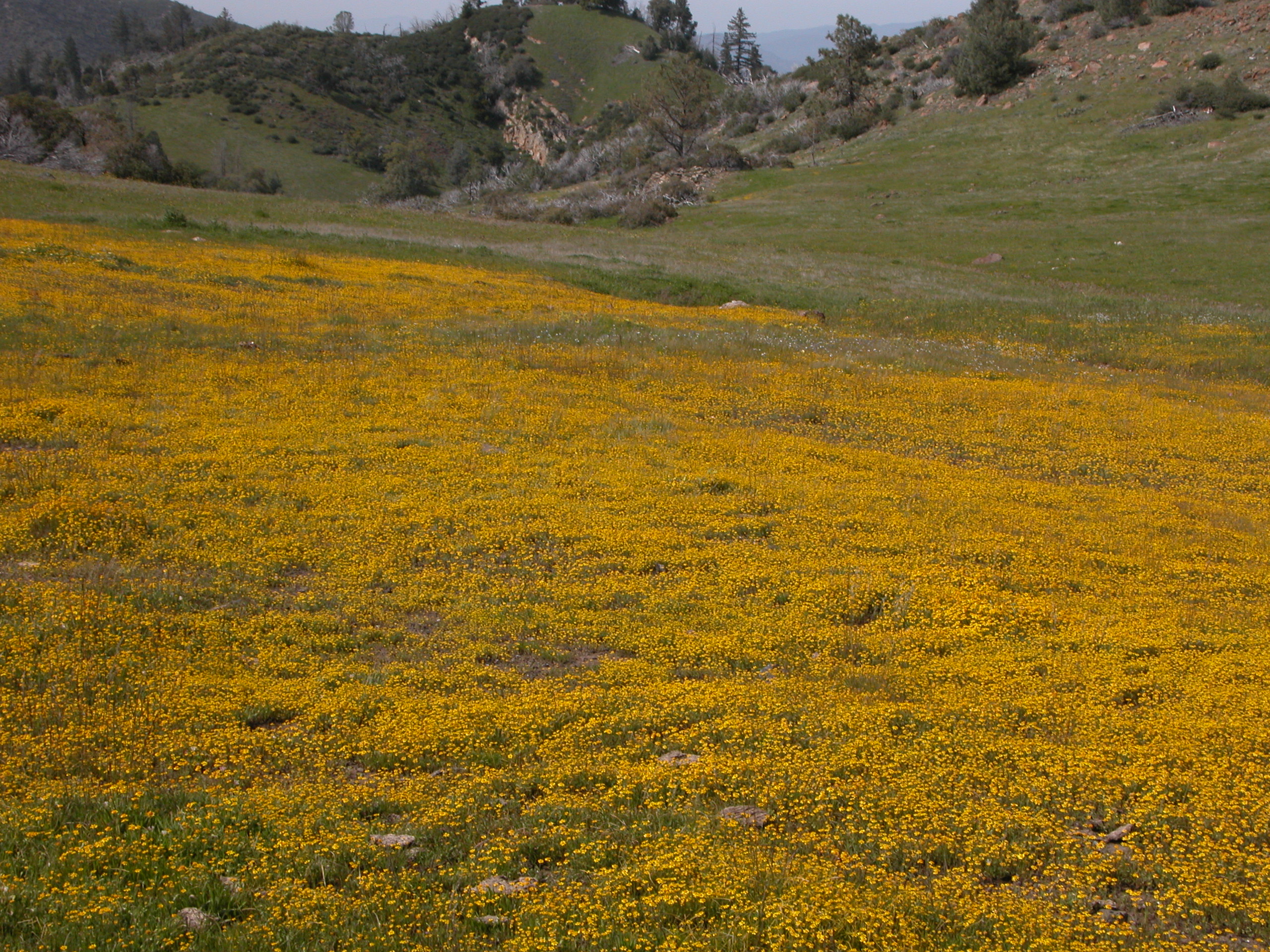|
San Rafael Mountains
The San Rafael Mountains are a mountain range in central Santa Barbara County, California, U.S., separating the drainages of the Santa Ynez River and the Santa Maria River. They are part of the Transverse Ranges system of Southern California which in turn are part of the Pacific Coast Ranges system of western North America. Geography Most of the mountain range is within the Los Padres National Forest, and the northern slopes are included in the remote San Rafael Wilderness area. The highest peaks include Big Pine Mountain (), San Rafael Mountain () and McKinley Mountain (), none of which are easily accessible except by foot or horse. The highest peak at the southern edge of the range is Little Pine Mountain. Hurricane Deck is a spectacular block of sandstone that can be found deep in the San Rafael Wilderness. The Sisquoc River headwaters are on the north slopes of Big Pine Mountain. It is a designated Wild and Scenic River of the United States, and a tributary of the ... [...More Info...] [...Related Items...] OR: [Wikipedia] [Google] [Baidu] |
La Cumbre Peak
La Cumbre Peak is a peak in the Santa Ynez Mountains north of Santa Barbara, California and located within the Los Padres National Forest. Composed of boulders and slabs of the Matilija Sandstone amid groves of pine trees, it is the highest summit in proximity to the city. Adjacent to La Cumbre is Arlington Peak () and Cathedral Peak (). Other peaks within the Santa Ynez Range include Santa Ynez Peak, to the west, and Divide Peak, to the east. East Camino Cielo (originally known as ''Ridge Route'') was constructed between October 1930 and June 1931 as a single lane road that extended from San Marcos Pass to the summit of La Cumbre Peak. The intermittently curvaceous road was opened to the public, built with frequent turnouts and a set maximum speed limit of per hour. Today the road is frequently used by runners and cyclists for training, as the elevation gain is substantial and sustained, while there is relatively little car traffic. Construction of a fire lookout s ... [...More Info...] [...Related Items...] OR: [Wikipedia] [Google] [Baidu] |
Little Pine Mountain
Little Pine Mountain is a mountain in Santa Barbara County, California, in the Los Padres National Forest at the southern edge of the San Rafael Mountains. It separates the drainages of Oso Creek, which flows into the upper Santa Ynez River, from the drainage of Santa Cruz Creek, which flows into the middle section of the river via Lake Cachuma. The mountain is named for a thin grove of Coulter pines located on the summit. The mountain is reached by the Santa Cruz National Recreation Trail, and is a popular day hike and mountain biking route for residents of Santa Barbara during the winter months. There is a camp at Happy Hollow Spring near the summit. The rocks of the lower slopes of the mountain comes from the Franciscan Assemblage, which creates serpentine soils that support a unique chaparral ecosystem. Large deposits of dark-red cinnabar are exposed above ground. The middle slopes of the mountain are dominated by the Espada Formation. The summit largely consists of Matilij ... [...More Info...] [...Related Items...] OR: [Wikipedia] [Google] [Baidu] |
California Oak Woodland
California oak woodland is a plant community found throughout the California chaparral and woodlands ecoregion of California in the United States and northwestern Baja California in Mexico. Oak woodland is widespread at lower elevations in coastal California; in interior valleys of the Coast Ranges, Transverse Ranges and Peninsular Ranges; and in a ring around the California Central Valley grasslands. The dominant trees are oaks, interspersed with other broadleaf and coniferous trees, with an understory of grasses, herbs, geophytes, and California native plants. Oak savannas occur where the oaks are more widely spaced due a combination of lack of available moisture, and low-intensity frequent fires. The oak woodlands of Southern California and coastal Northern California are dominated by coast live oak ('' Quercus agrifolia''), but also include valley oak ( ''Q. lobata''), California black oak ( ''Q. kelloggii''), canyon live oak ( ''Q. chrysolepis''), and other Califor ... [...More Info...] [...Related Items...] OR: [Wikipedia] [Google] [Baidu] |
Chaparral
Chaparral ( ) is a shrubland plant plant community, community found primarily in California, southern Oregon, and northern Baja California. It is shaped by a Mediterranean climate (mild wet winters and hot dry summers) and infrequent, high-intensity crown fires. Many chaparral shrubs have hard sclerophyllous evergreen leaves, as contrasted with the associated soft-leaved, drought-deciduous, scrub community of coastal sage scrub, found often on drier, southern-facing slopes. Three other closely related chaparral shrubland systems occur in southern Arizona, western Texas, and along the eastern side of central Mexico's mountain chains, all having summer rains in contrast to the Mediterranean climate of other chaparral formations. Etymology The name comes from the Spanish language, Spanish word , which translates to "place of the scrub oak". ''Scrub oak'' in turn comes from the Basque language, Basque word , which has the same meaning. Overview In its natural state, chaparral is ... [...More Info...] [...Related Items...] OR: [Wikipedia] [Google] [Baidu] |
San Andreas Fault
The San Andreas Fault is a continental Fault (geology)#Strike-slip faults, right-lateral strike-slip transform fault that extends roughly through the U.S. state of California. It forms part of the tectonics, tectonic boundary between the Pacific plate and the North American plate. Traditionally, for scientific purposes, the fault has been classified into three main segments (northern, central, and southern), each with different characteristics and a different degree of earthquake risk. The average slip rate along the entire fault ranges from per year. In the north, the fault terminates offshore near Eureka, California, at the Mendocino triple junction, where three tectonic plates meet. The Cascadia subduction zone intersects the San Andreas fault at the Mendocino triple junction. It has been hypothesized that a major earthquake along the Cascadia subduction zone could trigger a rupture along the San Andreas Fault. In the south, the fault terminates near Bombay Beach, Califor ... [...More Info...] [...Related Items...] OR: [Wikipedia] [Google] [Baidu] |
Igneous
Igneous rock ( ), or magmatic rock, is one of the three main rock types, the others being sedimentary and metamorphic. Igneous rocks are formed through the cooling and solidification of magma or lava. The magma can be derived from partial melts of existing rocks in either a planet's mantle or crust. Typically, the melting is caused by one or more of three processes: an increase in temperature, a decrease in pressure, or a change in composition. Solidification into rock occurs either below the surface as intrusive rocks or on the surface as extrusive rocks. Igneous rock may form with crystallization to form granular, crystalline rocks, or without crystallization to form natural glasses. Igneous rocks occur in a wide range of geological settings: shields, platforms, orogens, basins, large igneous provinces, extended crust and oceanic crust. Geological significance Igneous and metamorphic rocks make up 90–95% of the top of the Earth's crust by volume. Igneous rocks ... [...More Info...] [...Related Items...] OR: [Wikipedia] [Google] [Baidu] |
Jurassic
The Jurassic ( ) is a Geological period, geologic period and System (stratigraphy), stratigraphic system that spanned from the end of the Triassic Period million years ago (Mya) to the beginning of the Cretaceous Period, approximately 143.1 Mya. The Jurassic constitutes the second and middle period of the Mesozoic, Mesozoic Era as well as the eighth period of the Phanerozoic, Phanerozoic Eon and is named after the Jura Mountains, where limestone strata from the period were first identified. The start of the Jurassic was marked by the major Triassic–Jurassic extinction event, associated with the eruption of the Central Atlantic magmatic province, Central Atlantic Magmatic Province (CAMP). The beginning of the Toarcian Age started around 183 million years ago and is marked by the Toarcian Oceanic Anoxic Event, a global episode of Anoxic event, oceanic anoxia, ocean acidification, and elevated global temperatures associated with extinctions, likely caused by the eruption of the Kar ... [...More Info...] [...Related Items...] OR: [Wikipedia] [Google] [Baidu] |
Metamorphic
Metamorphic rocks arise from the transformation of existing rock to new types of rock in a process called metamorphism. The original rock (protolith) is subjected to temperatures greater than and, often, elevated pressure of or more, causing profound physical or chemical changes. During this process, the rock remains mostly in the solid state, but gradually recrystallizes to a new texture or mineral composition. The protolith may be an igneous, sedimentary, or existing metamorphic rock. Metamorphic rocks make up a large part of the Earth's crust and form 12% of the Earth's land surface. They are classified by their protolith, their chemical and mineral makeup, and their texture. They may be formed simply by being deeply buried beneath the Earth's surface, where they are subject to high temperatures and the great pressure of the rock layers above. They can also form from tectonic processes such as continental collisions, which cause horizontal pressure, friction, and distort ... [...More Info...] [...Related Items...] OR: [Wikipedia] [Google] [Baidu] |
Sedimentary
Sedimentary rocks are types of rock formed by the cementation of sediments—i.e. particles made of minerals (geological detritus) or organic matter (biological detritus)—that have been accumulated or deposited at Earth's surface. Sedimentation is any process that causes these particles to settle in place. Geological detritus originates from weathering and erosion of existing rocks, or from the solidification of molten lava blobs erupted by volcanoes. The geological detritus is transported to the place of deposition by water, wind, ice or mass movement, which are called agents of denudation. Biological detritus is formed by bodies and parts (mainly shells) of dead aquatic organisms, as well as their fecal mass, suspended in water and slowly piling up on the floor of water bodies ( marine snow). Sedimentation may also occur when dissolved minerals precipitate from water solution. The sedimentary rock cover of the continents of the Earth's crust is extensive (73% of the ... [...More Info...] [...Related Items...] OR: [Wikipedia] [Google] [Baidu] |
Figueroa Mountain
Figueroa Mountain is a summit in Santa Barbara County in the U.S. state of California. It is in the San Rafael Mountains, part of the Transverse Ranges group of ranges. The mountain is located in Los Padres National Forest. Figueroa Mountain was named for a member of the well-known southern California family, the most eminent of whom was José Figueroa, governor of Alta California in 1833–35. In turn, the mountain itself served as the inspiration for the name for the Figueroa Mountain Brewing Company. The Figueroa Mountain Recreation Area has excellent spring wildflower displays after wet winters. Late March brings out the early blooming specimens such as purple shooting stars ( Dodecatheon clevelandii ssp. clevelandii). Later arrivals on the mountain include chocolate lilies (Fritillaria biflora), and the scarlet Indian paintbrush (Castilleja spp). The open grassland areas support a profusion of annual species including goldfields (Lasthenia spp.), sky lupine ( Lupinus nanu ... [...More Info...] [...Related Items...] OR: [Wikipedia] [Google] [Baidu] |
Madulce Peak
Madulce Peak is a mountain located in the San Rafael Mountains, in the Transverse Ranges. It is the highest point of the Dick Smith Wilderness. The summit contains an old fire lookout that was constructed in the 1930s, but was burned down in the 1970s. Name The mountain was originally named Strawberry Peak by surveyors. Over the years, the name "Madulce" was gradually adopted. The Board on Geographic Names originally believed that "madulce" was the Spanish word for "strawberry". Etymological work done by the United States Forest Service The United States Forest Service (USFS) is an agency within the United States Department of Agriculture, U.S. Department of Agriculture. It administers the nation's 154 United States National Forest, national forests and 20 United States Natio ... ascertained that the word is actually local farmhand slang for "strawberry", from the Catalan word "maduixa". References Mountains of Santa Barbara County, California San Rafael Mountains Los ... [...More Info...] [...Related Items...] OR: [Wikipedia] [Google] [Baidu] |
Sisquoc Falls
Sisquoc Falls is a large plunge type waterfall located in the San Rafael Mountains of Santa Barbara County, California, about east of Santa Maria. It is located in the backcountry of the San Rafael Wilderness on Falls Canyon Creek, a tributary of the Sisquoc River. One of the tallest waterfalls in Southern California, the falls stand at least high, dropping off the edge of a semi-circular natural amphitheatre into a long and deep pool. Many smaller cascades occur both above and below the main drop. Fed by a fairly large and high elevation watershed, the falls flow strongly between December and April but diminish to a trickle by late summer. The falls are extremely difficult to access, requiring a one way hike from the closest road. In addition, the waterfall itself sits in the Sisquoc Condor Sanctuary, which is off limits to the public, so it can only be legally viewed from a distance. See also *List of waterfalls This list of notable waterfalls of the world is sorted b ... [...More Info...] [...Related Items...] OR: [Wikipedia] [Google] [Baidu] |






